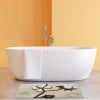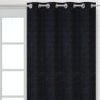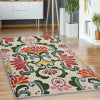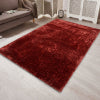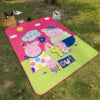Transforming Your Bedroom with Simple Color Psychology
Posted by AMIT KUMAR

"Colors, like features, follow the changes of the emotions." - Pablo Picasso
Imagine entering a bedroom where every hue whispers a story, where the colors are not just a feast for the eyes but a balm for the soul. This is the power of color psychology in bedroom decor. In this blog, we'll explore how the simple act of choosing your bedsheet color can transform your bedroom into a sanctuary that resonates with your inner self.
1. The Influence of Bedsheet Color on Mood and Sleep
Colors are more than just aesthetic choices; they are a language that speaks to our subconscious. Choosing the right color for your bedsheets can have a significant impact on your mood and sleep quality.
Calming Colors for Better Sleep
The colors you choose for your bedroom, especially for elements like bedsheets, play a crucial role in the overall mood and atmosphere of the space. Certain colors are particularly beneficial for promoting relaxation and enhancing sleep quality:
Blue: This color is often associated with calmness and serenity, making it an ideal choice for a bedroom. Blue is known for its calming effect on the mind and body, helping to reduce blood pressure and heart rate, which are essential for a restful night's sleep. Consider soft shades of blue, like sky or periwinkle, for your bedsheets to create a peaceful and tranquil sleep environment.
Soft Green: Evocative of nature, soft green shades can transform your bedroom into a restorative and refreshing haven. Green is believed to reduce stress and create a sense of balance and harmony. Opt for muted greens like sage or seafoam for your bedsheets to bring the tranquility of the outdoors into your bedroom.
Lavender: Known for its gentle, soothing presence, lavender is another excellent choice for promoting relaxation and stress relief. Its subtle yet enchanting hue can help calm the mind and ease anxiety, making it perfect for creating a serene and peaceful bedroom atmosphere. Lavender-colored bedsheets can be a great way to incorporate this calming color into your decor.
Stimulating Colors for an Active Vibe
While calming colors are beneficial for relaxation and sleep, stimulating colors can energize and invigorate. However, these colors may not be the best choice for a bedroom environment:
Red: This color is vibrant and full of energy, often associated with passion and excitement. While red can be stimulating and invigorating, it might be too much for a bedroom, where the primary focus is on relaxation and rest. If you love red, consider using it in accent pieces rather than the primary color of your bedsheets.
Bright Orange: Cheerful and full of life, bright orange can create a sense of enthusiasm and energy. However, like red, it can be overpowering in a bedroom setting. Its vibrant nature might be more suited to areas of activity and social interaction. If you're drawn to orange, softer shades like peach or apricot in your bedroom linens can offer a more subdued and restful alternative.
2. Harmonizing Bedsheet Colors with Wall Hues
The interplay between the colors of your bedsheets and your bedroom walls is a crucial aspect of interior design. This harmony of colors can create a cohesive and aesthetically pleasing environment. Here’s how to achieve this balance:
Complementary Color Schemes
This approach uses the principles of color theory to create a visually appealing contrast between bedsheet and wall colors. Complementary colors are opposite each other on the color wheel, meaning they provide a high contrast and high impact look while maintaining color harmony.
Soft Contrasts: This involves pairing lighter and darker shades to create a sense of balance without overwhelming the room. For example, cream bedsheets can beautifully offset a navy wall, offering a sophisticated and calming environment. This contrast is pleasing to the eye and can make the colors pop without being too stark.
Color Wheel Complements: This strategy involves selecting colors that are directly opposite each other on the color wheel, such as blue and orange or purple and yellow. This can create a dynamic and lively room decor. For instance, a bedsheet in a soft orange hue can complement a deep blue wall, adding vibrancy and energy to the room.
Monochromatic and Analogous Themes: These themes provide a more unified and serene visual experience. They are particularly effective in creating a relaxing and harmonious bedroom environment.
Monochromatic Schemes: This involves using different shades, tints, and tones of the same color. For instance, a room with pale blue walls can be complemented by navy blue cotton bedsheet and sky blue accents. This creates a cohesive and elegant look, using varying intensities of the same hue to add depth and interest.
Analogous Schemes: This strategy uses colors that are next to each other on the color wheel. They usually match well and create serene and comfortable designs. For example, bedsheets in a soft lavender color can harmonize beautifully with walls in a gentle rose hue. This combination is often found in nature and is pleasing to the eye, creating a relaxed and cohesive look.
3. Utilizing Color Psychology to Enlarge Smaller Spaces
The colors chosen for a small bedroom can significantly affect its perceived size and atmosphere. By understanding and applying color psychology, you can create an illusion of space, making the room feel larger and more welcoming.
Light and Bright Colors for Space Illusion
Light colors are known for their ability to make a space feel open and airy. They reflect more light, which helps to visually expand the area.
Whites and Creams: These colors are excellent for maximizing light reflection, thus contributing to a sense of increased space. White or cream bedsheets and walls can make the room feel brighter and more open. They serve as a neutral backdrop, allowing for flexibility in adding accents and textures.
Pastels: Soft pastel colors offer a gentle way to introduce color into a room without sacrificing the open feel. Light blues, greens, pinks, and lavenders can add a touch of personality while keeping the space light and airy. Pastel-colored bedsheets or wall paints can create a serene and spacious ambiance, perfect for small bedrooms.
Strategic Use of Dark Colors
While light colors are effective in creating a sense of space, dark colors can also be used strategically to add depth and character to a room without making it feel cramped.
Accent Walls: Painting one wall in a darker shade or using a dark-colored wallpaper can create a focal point and add depth to the room. This technique draws the eye, giving the illusion of an extended space. For instance, a deep blue accent wall can make the room look more profound and more spacious.
Dark Accents: Introducing dark colors through smaller elements like pillows, throws, or bedsheet trims can add contrast and interest without overwhelming the space. These dark accents can create a cozy and grounded feeling in the room. For example, using navy blue pillows or a dark gray throw can enhance the room's aesthetics while maintaining a spacious feel.
4. Trending Bedroom Colors for 2024
Staying current with color trends can refresh the look of your bedroom and make it feel more modern and stylish. For 2024, the trend leans towards nature-inspired tones that provide a calming retreat and bring the serenity of the natural world indoors.
Nature-Inspired Tones for a Calming Retreat
The trend towards earthy colors reflects a growing desire for spaces that evoke a sense of peace and connection to nature.
Olive Green: This muted, earthy tone is gaining popularity for its soothing and grounding qualities. Olive green can bring a sense of tranquility to your bedroom, reminiscent of the calming aspects of nature. It pairs well with natural wood tones and other neutral colors, making it versatile for various design styles.
Terracotta: A warm, nurturing color reminiscent of natural landscapes, terracotta brings a cozy and comforting feel to the bedroom. Its rich, earthy hue can be paired with creamy whites or deep greens for a sophisticated, nature-inspired palette.
.
Bright and Bold as Accents: While nature-inspired tones dominate, there's still room for bright and bold colors, used thoughtfully as accents to add vibrancy and energy to the bedroom.
Accent Pieces: Incorporating trendy bright colors through smaller items or accessories is an excellent way to refresh your bedroom's look without committing to a complete overhaul. Think about adding pillows, throws, or artwork in vibrant hues to add pops of color.
Seasonal Updates: Changing bedsheet colors with the seasons or according to the latest trends is a great way to keep your bedroom feeling fresh and current. For instance, using lighter, brighter colors in the spring and summer and switching to richer, deeper tones in the fall and winter can keep your bedroom in sync with the outside world. Keeping the base elements of your room in neutral tones allows for these easy updates without clashing with the existing decor.
5. Bonus Tips
Color Pairings: Experiment with different color pairings on smaller items like cushions or art to see how they affect the room's mood before committing to larger changes.
Daylight Influence: Observe how natural daylight interacts with your bedroom colors. Some colors might change hue throughout the day, affecting the room's ambiance.
Neutral Bases: Start with a neutral base for walls or main furniture pieces; it's easier to add color accents to a neutral palette than to adjust an already colorful space.
Color Flow: Ensure a harmonious color flow from your bedroom to adjacent areas. This continuity creates a sense of balance throughout your living space.
Personal Preference: Always prioritize personal color preferences over trends. Your comfort and connection with the color are most important.
Test Swatches: Use test swatches for paint or fabric samples in the room before making final decisions. This helps in visualizing the actual look.
Psychological Comfort: Choose colors that bring you psychological comfort, like a favorite color from childhood or a hue that evokes a cherished memory.
Temporary Color Changes: Use temporary or seasonal decor items like throws, rugs, or curtains to experiment with colors without a permanent commitment.
Mood Boards: Create mood boards with your desired color palette to visualize how different colors and textures work together.
Balanced Lighting: Balance artificial lighting in your bedroom to complement your color choices, as different types of lighting can affect how colors are perceived.
Conclusion:
Your bedroom is more than just a place to sleep; it's a personal sanctuary where every element, from the color of your bedsheets to the texture of your throw pillows, contributes to your overall well-being. By understanding and utilizing the principles of color psychology, you can transform your bedroom into a space that not only looks beautiful but also resonates with your emotional and psychological needs, ensuring that every moment spent there is in harmony with your inner self.
TAGS:


































